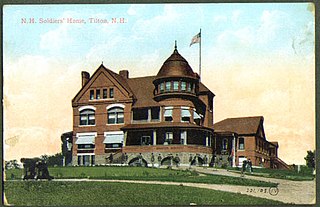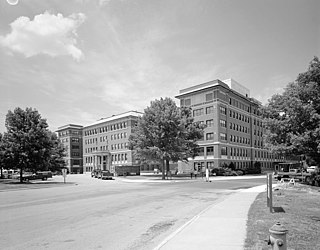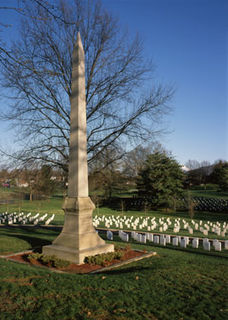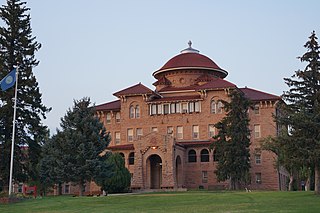
An old soldiers' home is a military veterans' retirement home, nursing home, or hospital, or sometimes an institution for the care of the widows and orphans of a nation's soldiers, sailors, and marines, etc.

Herron–Morton Place is a historic district in Indianapolis, Indiana, dedicated to restoration and renewal. The boundaries of the neighborhood are East 16th Street on the south, East 22nd Street on the north, the alley west of North Pennsylvania on the west, and Central Avenue on the east.

Togus, formally known as the Togus VA Medical Center, is a facility operated by the United States Department of Veterans Affairs in Chelsea, Maine. The facility was built as a resort hotel, and housed Union veterans of the American Civil War prior to being converted to a veterans hospital. It was the first veterans facility developed by the United States government.

The Director's Quarters, Togus Veterans' Administration Center, previously known as the Governor's House, is a historic house on the grounds of the Veterans Administration (VA) facility in Togus, Maine. The house, built in 1869, is historically significant as the only surviving structure of the first National Home for Disabled Volunteer Soldiers, established at Togus in 1866 to serve American Civil War veterans. It was designated a National Historic Landmark in 1974. It is a contributing element of the historic district encompassing the Togus VA campus.

Wadsworth Chapel, also known as the Catholic-Protestant Chapels, is actually two separate chapels under one roof on the campus of the Dept. of Veterans Affairs Medical Center in West Los Angeles, California. The structure was built in 1900 and was closed in 1971 after being damaged in the 1971 Sylmar earthquake. It is the oldest building on Wilshire Boulevard and was listed in the National Register of Historic Places in 1972. The structure has fallen into a state of disrepair due to the lack of funds within the Dept. of Veterans Affairs to pay for the required repairs and renovation.

The Sawtelle Streetcar Depot is located on the grounds of the Sawtelle Veterans Home in Sawtelle, in the Westside area of Los Angeles, California.

Saint Joseph College and Mother Seton Shrine are two closely related campuses in Emmitsburg, Maryland, United States. It forms a historic district that was listed on the National Register of Historic Places in 1976.

The Franklin County G. A. R. Soldiers' Memorial Hall, also known simply as the Soldiers' Memorial Hall, is a historic building located in Hampton, Iowa, United States. The octagonal-style structure was designed and built in 1890 by Edward Carl Keifer. It was the meeting place of the J.W. McKenzie Post No. 81, Grand Army of the Republic (G.A.R.), which was one of 519 GAR posts in Iowa. The building is architecturally significant as it is one of the few examples of a Gothic Revival style structure of this type in the area. It is a memorial chapel that follows a cross-shaped plan capped by an octagonal cupola with a statue of a Union soldier on top. Its significance is also derived from it being the first G.A.R. Memorial Hall built in Iowa. The Iowa legislature had passed a law in 1884 that allowed counties to levy a tax to support building G.A.R. memorials. Captain Rufus S. Benson, a local state representative, had the law amended in 1886 so that it allowed for the construction of a memorial hall, as the local G.A.R. chapter wanted it to be a place where they could meet.

The Sawtelle Veterans Home was a care home for disabled American veterans in what is today part of the Los Angeles metropolitan area in California in the United States. The Home, formally the Pacific Branch of the National Home for Disabled Volunteer Soldiers, was established in 1887 on 300 acres (1.2 km2) of Rancho San Vicente y Santa Monica lands donated by Senator John P. Jones and Arcadia B. de Baker. The following year, the site grew by an additional 200 acres (0.81 km2); in 1890, 20 acres (0.081 km2) more were appended for use as a veterans' cemetery. With more than 1,000 veterans in residence, a new hospital was erected in 1900. This hospital was replaced in 1927 by the James W. Wadsworth Hospital, now known as the West Los Angeles VA Medical Center.

The National Home for Disabled Volunteer Soldiers, Marion Branch is a historic old soldiers' home located in Marion, Indiana. The hospital, along with Marion National Cemetery were listed on the National Register of Historic Places in 1999 as a national historic district.

Edward Townsend Mix was an American architect of the Gilded Age who designed many buildings in the Midwestern United States. His career was centered in Milwaukee, Wisconsin, and many of his designs made use of the region's distinctive Cream City brick.

Danville is a city in and the county seat of Vermilion County, Illinois. As of the 2010 census, its population was 33,027. As of 2019, the population was an estimated 30,479.

Seaview Hospital was a historic tuberculosis sanatorium, now a national historic district located at Willowbrook on Staten Island, New York. The complex was planned and built between 1905 and 1938 and was the largest and most costly municipal facility for the treatment of tuberculosis of its date in the United States.

The Northwestern Branch, National Home for Disabled Volunteer Soldiers Historic District is a veterans' hospital in Milwaukee, Wisconsin with roots going back to the Civil War. Contributing buildings in the district were constructed from 1867 to 1955, and the 90 acres (36 ha) historic district of the Milwaukee Soldiers Home campus lies within the 400 acres (160 ha) Clement J. Zablocki VA Medical Center grounds, just west of Miller Park.

Ward Memorial Hall is an 1880s theater building within the Northwestern Branch, National Home for Disabled Volunteer Soldiers Historic District, located in Milwaukee, Wisconsin. It is part of the Milwaukee Soldiers Home complex, designated Building No. 41, on the present day Clement J. Zablocki VA Medical Center grounds.

The Western Branch of the National Home for Disabled Soldiers was established in 1885 in Leavenworth, Kansas to house aging veterans of the American Civil War. The 214-acre (87 ha) campus is near Fort Leavenworth, and is directly adjacent to Leavenworth National Cemetery, south of Leavenworth town. The home features about 82 contributing building resources, constructed between the 1880s and the 1940s. It is now part of the Department of Veterans Affairs Eisenhower Medical Center.

The Soldiers' Home Historic District, a historic Old soldiers' home campus, is located in Columbia Falls, Flathead County, Montana.

The Dayton Veterans Affairs Medical Center is located at 4100 West 3rd Street in Dayton, Ohio. Founded in 1867, it is one of the three oldest facilities of what is now the United States Department of Veterans Affairs. When founded, it was known as the Central Branch of the National Home for Disabled Volunteer Soldiers, and it is under this name that a portion of its campus, along with the adjacent Dayton National Cemetery, was designated a National Historic Landmark District in 2012, for its role in the history and management of veterans affairs.

The Mountain Branch, National Home for Disabled Volunteer Soldiers was an old soldiers' home opened in 1904 in Mountain Home, Johnson City, Tennessee. Its site has since been taken over by the United States Department of Veterans Affairs, and is home to the Mountain Home National Cemetery and the James H. Quillen VA Center. Also known as the Mountain Home, its campus was designated a National Historic Landmark District in 2011, as a well-preserved example of an early 20th-century veterans care facility.

The Battle Mountain Sanitarium was a division of the National Home for Disabled Volunteer Soldiers (NHDVS) located in Hot Springs, South Dakota. Established by law in 1902 and opened in 1907, it was unique among the facilities of the NHDVS, a precursor of today's United States Department of Veterans Affairs (VA), in that it was strictly a medical facility with no residential components beyond its treatment facilities. It was founded to treat former soldiers suffering from musculo-skeletal problems that were believed to be treatable by the region's mineral springs, and for conditions such as tuberculosis whose treatment was improved by the thin dry air. The facilities built for the sanitarium are in an architecturally distinctive Romanesque and Mission Revival style, and now form the centerpiece of the Black Hills Health Care facility, operated by the VA. Most of the complex site was designated a National Historic Landmark in 2011 for its architecture and history.






















